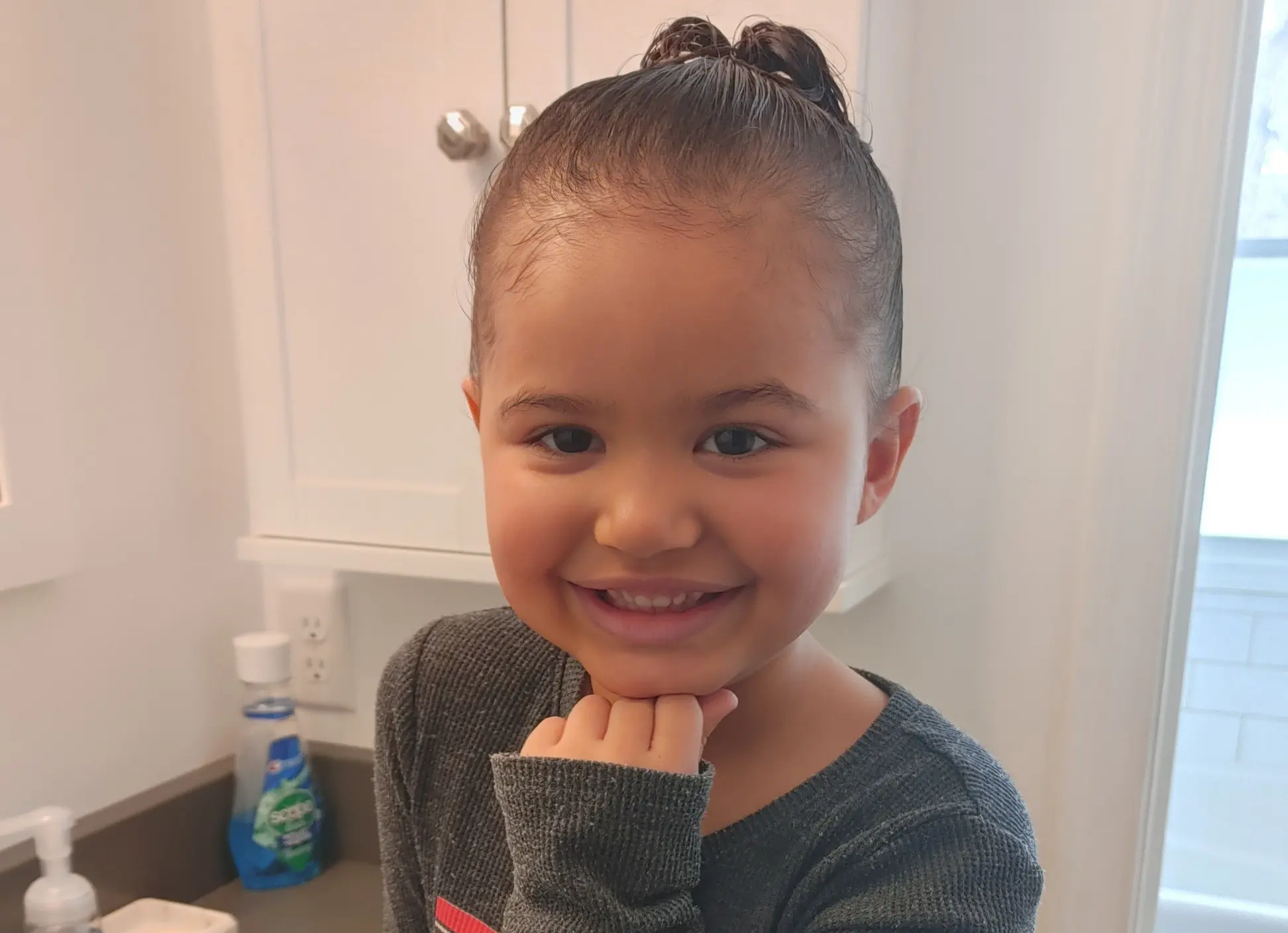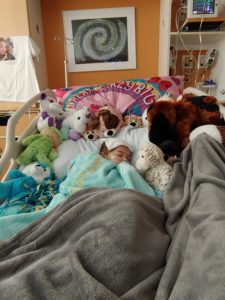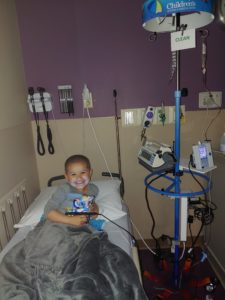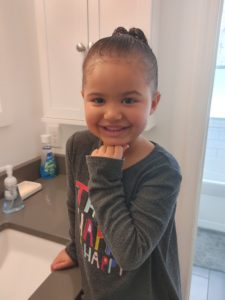Nola’s Journey: A 3-year old’s battle against a fast-growing cancer
“I was worried about her. She wasn’t acting like herself at all,” explains Heather. “I took her to her pediatrician, and they told me she was likely having growing pains in her legs since she was on the path to be a very tall little girl.”
Heather wasn’t exactly sure what to think but took the advice of her pediatrician and took Nola home and kept watching her. A few months later, Heather went in to wake up her daughter and was surprised to see bruises all over her body. They were all over her arms and legs, and Heather knew her daughter hadn’t had a fall or been playing rough recently.
“I had no clue what was going on, so I took her back to the doctor and they ran some bloodwork,” said Heather. “I took her back home and, within an hour, the doctor called us and told us we needed to head to the hospital immediately.”
Heather received news that a mother never wants to receive. Nola had leukemia and needed to start treatment right away. It was April 24, 2019, a date Heather says she will never forget.
“As soon as I heard that word, I lost my breath and went and threw up,” remembers Heather.
Luckily, Heather was only 10 minutes away from Children’s Nebraska. Children’s has doctors that specialize in diagnosing and treating a wide range of childhood cancers and blood-related conditions, and Heather’s pediatrician had arranged for her to meet with the team right away.
When Heather arrived, they began hooking Nola up to IVs and doing lots of bloodwork to identify the exact cancer Nola would be fighting. They performed a spinal tap, and Nola needed a blood transfusion and platelets. The next day they learned Nola had acute lymphoblastic leukemia (ALL) and it had spread across 99% of her little body. Also called B-cell acute lymphocytic leukemia, this cancer is an aggressive and fast-growing type of leukemia in which too many B-cell lymphoblasts are found in the bone marrow and blood. It is the most common type of acute lymphoblastic leukemia.
The treatment plan would be two and a half years of chemotherapy, a special type of drug used to kill cancer cells. In the first year, Nola would receive chemo five days a week and, like many cancer patients, Nola would get sick very easily during her treatments due to a compromised immune system. She would end up spending six months out of that first year at Children’s.
Heather worked at the Oak Hills Country Club in Omaha, and when Nola got sick, she wasn’t able to work much at all during that first year.
“We spent so much time in the hospital that first year,” explains Heather. “My mom and sister would help me with my other three children, and my job was so understanding and let me be at the hospital with her whenever I needed. My mom and I would switch off so I could leave each night for a few hours to shower and spend time with my other children. I’m not sure what I would have done without my wonderful support system.”
Heather explained how the members at the country club were constantly looking for ways to help.
“They wrote us checks, paid for stuff for us and sent us money,” remembers Heather. “My mom and I would use the money to send stuff to the hospital like toys and crafts and a whole bunch of tie blankets that we would make. It was so touching to see how extremely supportive everyone was.”
During her hospital stays, Nola would get a spinal tap almost every week to make sure the cancer hadn’t spread to her spinal cord. She needed lots of platelets and blood infusions, and when COVID-19 hit in the spring of 2020, she was getting COVID-19 tested regularly before each treatment.
“During this time, the hospital and staff were amazing. They have staff that volunteer to play with kids and there would be people coming in the room almost every day to come play playdough with her or have a tea party or sing songs with her,” remembers Heather. “Every nurse that would come in would play and talk with her. It meant so much that they cared so much for her.”
Even though Nola was battling cancer, she has fond memories of her time in the hospital and she was excited to tell us about it.
In her sweet little voice, Nola chimed in, “And they would bring the dog into the room, and I would pet her, and they would play tea party with me.”
In the year and a half after her long hospital stays, Nola’s treatment went from five days a week to having to come in every other week and then monthly. She is now only a few months away from the completion of her treatment, and then will be on a maintenance plan where she will only need to be checked a couple times a year to make sure she is still in remission.
Today, Nola is a happy 5-year-old. She is healthy, playful and, according to Heather, a big talker and a big eater.
Nola felt this was a good time to chime in again: “I like fruit, not vegetables.”
Heather credits the wonderful team of oncologists, nurses and staff members for getting Nola and her through this incredibly hard journey.
“They have done the most amazing job, not only with me but with Nola,” said Heather. “They always explained everything to her before doing any procedure and would explain exactly what was going to happen. They would let her ask all her questions and make sure she was ok with everything, even though she was only 3 years old. There wasn’t anything she asked for that she didn’t get.”
Heather even remembers a time when they were the last patients in the Infusion Center that day and the nurses came over to Nola and asked if she wanted to play hide and seek.
“They were running around the Infusion Center with Nola’s IV pole in tow, hiding from each other. It was the sweetest thing,” remembers Heather.
This fall, Children’s will be opening the Hubbard Center for Children and will be investing even more resources into helping children like Nola who are diagnosed with cancer. An entire floor will be dedicated to children and teens diagnosed with cancers and blood disorders. Having a dedicated floor will improve infection control for immunocompromised patients and allows children to get out of their rooms as much as possible.
Heather feels this will be a game-changer for these kids.
“I think what they are building for these children is so amazing,” said Heather. “When Nola was first diagnosed, we were watching them build this new part of the hospital, and it was so cool to watch. These kids who are getting diagnosed with these rare diseases and cancers like Nola are really going to benefit. It’s amazing to see all the technology they are adding. To know this new facility will help all these children survive and be able to have a better life when they get older means so much to us.”
Heather is thankful that Nola’s cancer journey is coming to an end. While her past two years have been turned upside down, she still feels like she has so much to be grateful for.
“This was a crazy adventure, but I am so grateful that I live in a city that has a hospital like Children’s to care for Nola,” said Heather. “Every single person we encountered—from the doctors, nurses, Child Life staff and volunteers—has been so caring, and we both wouldn’t have been able to get through this experience without them and the support of our community. Thank you, Children’s!”



